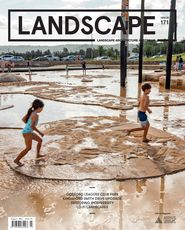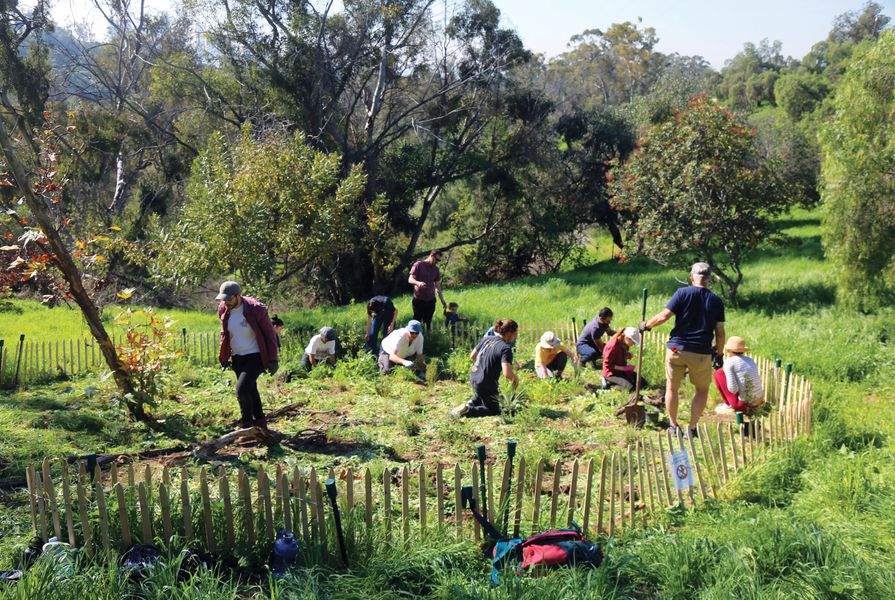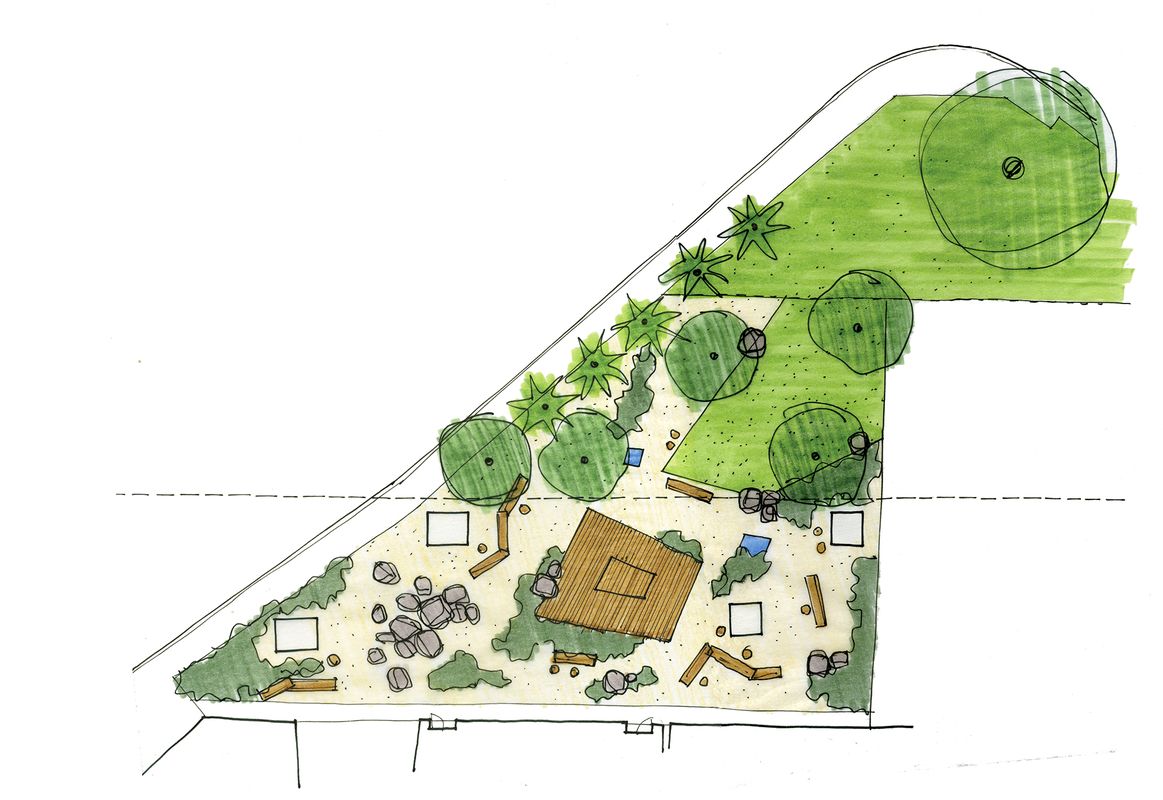Terremoto, founded by David Godshall and Alain Peauroi, has offices in Los Angeles and San Francisco. In the first interview in our series, Liam Mouritz and Alex Breedon spoke with Godshall about creating designs that are conceptually rich and contextually appropriate, and how their mode of working contrasts with more corporate landscape architecture practice.
Alex Breedon: Looking at Terremoto’s website, there aren’t design drawings, but instead a lot of images of projects during construction. What kind of relationship do you have with landscape contractors?
David Godshall: A lot of people think we’re “design and build,” but we’re technically not. We’re an aberration – we’re so deeply involved with construction that the boundaries between design and construction are blurred. When building our practice, we burned through a lot of bad contractors and now we’ve found people we really like to work with.
We’ve always photographed the construction process of our projects and published it widely. Originally, it was just something we did because we found it so interesting. But the more we do it, the more we find ourselves asking, “Why don’t other people document and publish this?” It’s strange to just showcase built work, where all you see is the final perfect built outcome. We know that landscape is messy and to portray that explicitly is important to us.
Liam Mouritz: So, what happens in your projects after construction?
DG: Gardens are outcomes of processes. There’s no denying that. We’re happy with the way we portray construction and labour, but this notion of maintenance is also eternally fascinating to us. We finish a project and it’s really just getting started!
I hope that at least at the residential scale, we’re heading towards a horticultural renaissance that really feeds into all of this messiness, simplicity and frugality we’re talking about. I think we’re at these crossroads, at least in California, where gardens are getting weirder, wilder and more ecologically diverse, but there is a dearth in gardening skill within the maintenance industry. We’re always coming up against this and we spend a lot of time trying to train maintenance people to work differently in the gardens we design.
The construction team from Barranca Landscape heave a large rock into place at Terremoto’s garden for Mohawk West in Los Angeles.
Image: courtesy Terremoto
Construction of Forest Paths, a series of stairs and pathways connecting cabin structures in a mixed madrone, oak and redwood forest north of San Francisco.
Image: courtesy Terremoto
LM: Moving beyond the garden, do you have any thoughts about landscape architecture’s ability to address broader scale issues relating to the planning of cities and regions?
DG: With regards to the evolution of cities, we need to touch on gentrification. It’s a tough subject. We live and work in Echo Park where there is a young creative class moving in. When we’re designing gardens in these changing neighbourhoods, what we’re trying to grapple with is how we can improve this garden while not erasing its previous manifestation. What we try to do is to marry the new and the old in the site through horticulture, to maintain a continuity with what currently exists, while making something different and more ecologically focused. Across the world, cities, areas and regions express themselves through botany. As cities change, we gravitate towards the region’s botanical history in our designs in order to give the project some “creative context.”
We’re also very much into the idea of a patchwork ecology, in that, if we’re consistently doing ecologically rich gardens, there will eventually be a positive impact. Not all, but many plants and animals can survive in a patchwork. Butterflies, for example, thrive in urban patchwork ecologies. This approach can become an ecological framework. Say, if Terremoto, over the next 30 years, does 3,000 small residential gardens in Los Angeles, we could theoretically usher in a sincere ecological response for local species.
Having said that, we’re not against doing larger infrastructural landscape projects. We’ve tried a few times, with projects up to the campus-level size, but we’re hesitant, because we haven’t yet been able to do them on our own terms. We’ve seen them as a great opportunity to do the Terremoto thing on a much larger scale, but we’ve found out that these types of projects really chew us. Clients aren’t interested in poetics at that scale. The opportunity to have slower, more nuanced conversations is gone, instead it’s all about renderings and constantly updating documentation packages. I think it’s a shame, because I think we could apply our process to a much larger scale, but we just haven’t found the right project yet.
Test Plot, in a degraded park near downtown Los Angeles, currently comprises four circular plots, identical in size and shape but subject to different conditions of sunlight and shade, exposure and gradient.
Image: Terremoto
At Test Plot, each plot has been planned with species native to Southern California and to the site in pre-colonial times.
Image: Terremoto
AB: We can see through your work that the typical mantra of “bigger is better” is being challenged.
DG: It’s kind of strange here, in North America, where I feel like the corporate business structure that prevailed in the ’80s and ’90s is still hanging on. Bigger is better, you have to scale up and if you don’t grow you die. I think we’re at an interesting time – I’ve been speaking to a lot of people who are questioning this working structure. It’s more fun if we have a culture of tons of small offices designing lots of great projects, rather than a few larger offices just focusing on big stuff. I think we can change this dominant structure, and one way that Terremoto hopes to do this is to continue to build projects that are clearly different.
Another thing to add is that, especially when I started working, there was a mantra that “the more expensive the better,” the more complex the design detail and construction, the better the project. And when starting Terremoto, we just flat out refused to follow this. I really think that there’s going to be a bigger return to this design simplicity that we aim for.
AB: I heard you mention before that your Platform Park concept that transformed a vacant lot in an underpass in Culver City involved “no program.” Can you talk about program and its relation to garden design and landscape architecture?
DG: A garden, in theory, doesn’t really need a justification. Whereas, in architecture there is a real need for architects to justify their buildings and spatial designs [in terms of function]. I actually think landscape urbanism is antithetical to the approach of “no program.” It’s often about performance and [in relation to a landscape design] is always asking, “What does this part do? What does that part do?” Even when that “doing” is about enabling indeterminate uses, there is still a preoccupation about the landscape “doing” something. While I think there is a place for that way of designing, I would hate to see it applied to all open space and landscape architecture projects.
Some of my favourite parks are just “blurry edges.” Golden Gate Park in San Francisco, for example, is a massive park, it’s so big that it therefore has these really large grey areas. You enter into the park and often the planting isn’t really intentional and the place is full of interstitial zones that are fascinating, while also being completely devoid of program. I think these are often the most beautiful parts of the park. I do think that in Europe, they are much better at asking very little of their open spaces other than to just “be” and to be places of gathering. Hopefully, there is a bigger shift in that direction in North American culture. There’s been this big movement in landscape urbanism, notable in response to the development of the High Line, to create these very prescriptive public spaces that leave little to no room for spontaneity. But if we look at how people have been using public space during the pandemic, it’s been the open, unprogrammed parks that have become the most beloved and most used, since the public has been able to use them organically and program them themselves. With Platform Park, considering its size, which is around a block long, it was easier, simpler and more effective to “let it be” and explore the idea of no program, rather than packing it full of stuff.
Members of the local community gather in Platform Park, Culver City on a sunny afternoon.
Image: Stephen Schauer
Seating formed from logs is craned into place beneath the concrete columns of the train track at Platform Park.
Image: courtesy Terremoto
LM: What’s a favourite project that you’re working on at the moment?
DG: Our most beautiful money pit at the moment is a project called Test Plot. Our local park, Elysian Park, is in a pretty bad state and we are organizing to build these “test plots” to restore this hillside that is totally racked by weeds and mismanagement. We’ve now planted our first four test plots and we’re working out what are the financial and mechanical human labour inputs that we can put into ecologically revitalizing this place.
We’re calling it a “rejuvenation project” because when we talked to the government and ecological restoration experts, they told us, “don’t call this ecological restoration,” because as soon as you say that it’s “restoration” there are a whole bunch of requirements that we would need to adhere to. They advised us against this because they thought that we were not going to be able to achieve this kind of puritanical version of restoration. We didn’t adhere to strict restoration standards, we were looser and freestyled it more. Thankfully, everyone was pleasantly surprised and next spring we’re going to extend the project.
Source

Practice
Published online: 13 Aug 2021
Words:
Alex Breedon,
Liam Mouritz
Images:
Stephen Schauer,
Terremoto,
courtesy Terremoto
Issue
Landscape Architecture Australia, August 2021

























